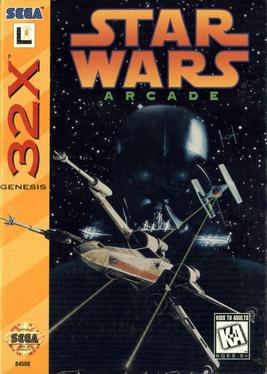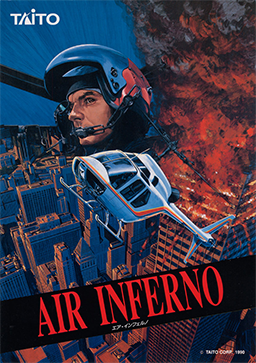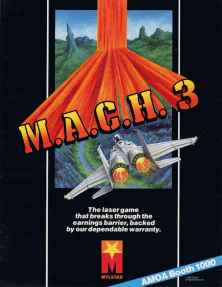Related Research Articles
Racing games are a video game genre in which the player participates in a racing competition. They may be based on anything from real-world racing leagues to fantastical settings. They are distributed along a spectrum between more realistic racing simulations and more fantastical arcade-style racing games. Kart racing games emerged in the 1990s as a popular sub-genre of the latter. Racing games may also fall under the category of sports video games.

Final Lap is a 1987 racing simulation video game developed and published by Namco. Atari Games published the game in the United States in 1988. It was the first game to run on Namco's then-new System 2 hardware and is a direct successor to Namco's Pole Position (1982) and Pole Position II (1983). It was ported to the Famicom by Arc System Works, making it Arc System Works’ debut game.

Chase H.Q. is a vehicular combat racing game, originally released as an arcade video game by Taito in 1988. It is sometimes seen as a spiritual successor to Taito's earlier Full Throttle. The player assumes the role of a police officer named Tony Gibson, member of the "Chase Special Investigation Department". Along with his partner, Raymond Broady, he must stop fleeing criminals in high-speed pursuits in a black Porsche 928.

Punch-Out!! is an 1984 arcade boxing video game by Nintendo. It was the first in a series of Punch-Out!! games.

Operation Wolf is a light gun shooter arcade game developed by Taito and released in 1987. It was ported to many home systems.

Operation Thunderbolt is a light gun shooter video game developed by Taito and released for arcades in 1988. As the sequel to Operation Wolf, changes include two-player gameplay with two positional gun controllers mounted on the arcade cabinet, and a new forward-scrolling pseudo-3D perspective combined with side-scrolling sections.

Virtua Racing or V.R. for short, is a Formula One racing video game developed by Sega AM2 and released for arcades in 1992. Virtua Racing was initially a proof-of-concept application for exercising a new 3D graphics platform under development, the "Model 1". The results were so encouraging that Virtua Racing was fully developed into a standalone arcade title.
The following article is a broad timeline of arcade video games.

Special Criminal Investigation, also known as S.C.I. for short or as Chase HQ II: Special Criminal Investigation in some home versions, is vehicular combat racing game published by Taito for arcades in 1989. It is the sequel to the 1988 game Chase H.Q.

Star Wars is a 1993 arcade game developed by Sega and based on the original Star Wars trilogy. Combining elements of A New Hope and Return of the Jedi, the game has players pilot a Rebel starship and battle against the forces of the Empire. Sega developed Star Wars for their Model 1 system, the same arcade hardware that powered Virtua Fighter and Virtua Racing. Like those two titles, the graphics in Star Wars are rendered entirely using polygons. The game was given a home port under the name Star Wars Arcade, as an exclusive for the Sega 32X's launch in 1994.

Air Inferno is a 1990 flight simulation arcade video game developed and released by Taito, in Japan, Europe and North America. A spin-off from Taito's Landing series, Air Inferno is an aerial firefighting simulation that involves piloting a helicopter on various rescue missions, shooting a fire extinguisher to extinguish flames while rescuing civilians.

Galaxy Force is a rail shooter video game developed and released by Sega for arcades in 1988. The player assumes control of a starship named the TRY-Z, as it must prevent the Fourth Empire from taking over the entire galaxy. Gameplay involves shooting down enemies using either a laser shot or a limited supply of heat-seeking missiles, all while avoiding collision with projectiles or obstacles and making sure the ship's energy meter doesn't fully deplete. It ran on the Sega Y Board arcade system, and was released with a motion simulator cockpit arcade cabinet version like previous Sega Super Scaler games.

Full Throttle, also known as Top Speed, is a one-player racing arcade game developed by Taito in 1987. It is very similar in style to the Out Run games in that it features a fast, red car hurtling through the US countryside. The key difference in gameplay is the addition of a nitro boost button. The game was released under the title Full Throttle in Japan, Top Speed in North America, and both Full Throttle and Top Speed in Europe.

Chase H.Q. 2 (チェイスH.Q.2) is a racing video game released in 2007 by Taito and developed by Gamewax in their London studio,. It is the sequel to Chase H.Q.. The game follows the formula of the original, but uses 3D graphics.

M.A.C.H. 3 is a shoot 'em up LaserDisc video game developed by Gottlieb and released for US arcades in 1983 under their Mylstar brand. The player controls a high-speed fighter aircraft in one of two missions: either a "Fighter Raid" seen flying forward at low altitude or "Bombing Run" seen in a top-down mode. Video backgrounds from the LaserDisc are overlaid by computer graphics. The title is both a reference to Mach number and is an acronym for "Military Air Command Hunter". It was released in Japan by Taito.

Under Fire is a light gun shooter released as an arcade game in 1994 by Taito. The game uses graphics created using digitized photographs and two player gameplay using gun controllers, similar to Konami's Lethal Enforcers. Unlike Lethal Enforcers, the controllers are not traditional light guns but rather operate using infrared technology. They also provide force feedback when the player pulls the trigger. The game was never released for home consoles.

Gun Buster, also known as Gunbuster (ガンバスター) and released in North America as Operation Gunbuster, is a first-person shooter video game developed by Taito and released for arcades in 1992. In contrast to on-rail light gun shooters at the time, this was one of the first arcade games to feature free-roaming FPS gameplay, the same year Wolfenstein 3D was released on personal computers.

Speed Race is a 1974 arcade racing video game developed and manufactured by Taito and released under the titles Racer and Wheels in North America by distributor Midway Manufacturing in 1975. Designed by Tomohiro Nishikado, the gameplay involves the player using the attached steering wheel to maneuver a car alongside a fast vertical scrolling road. The objective is to score points by driving past other cars without colliding with them; more points are awarded for driving faster. Players must do this under a 90-second time limit, which ends the game when it runs out. The gameplay concepts were adapted from two earlier driving electro-mechanical games: Kasco's Mini Drive (1958) and Taito's Super Road 7 (1970).
Landing is a series of flight simulator video games by Taito. Almost all games were released for arcades, except the Jet de Go! Series released for PlayStation consoles.

Night Striker is a 1989 shoot 'em up video game developed and published by Taito for the Taito Z System. In the game, the player flies an armoured car shooting enemy invaders to destroy a terrorist organisation. Night Striker combines gameplay elements of Sega's Space Harrier and Out Run. Versions were released for the Sega Mega-CD in 1993, Sony PlayStation in 1995, and Sega Saturn in 1996. A version was released on the Taito Memories II Gekan compilation for the PlayStation 2 in 2007. Night Striker received mixed reviews, and the Mega-CD version in particular was heavily criticised, primarily due to poor graphics. The music was composed by Taito's Zuntata sound team, and has been released separately.
References
- ↑ Taito 68020 Based Hardware, System 16: The Arcade Museum
- ↑ "Game Machine's Best Hit Games 25 - アップライト, コックピット型TVゲーム機 (Upright/Cockpit Videos)". Game Machine (in Japanese). No. 447. Amusement Press, Inc. 15 April 1993. p. 29.
- ↑ "Equipment Poll - Video & Pinball Combined". Play Meter . Vol. 19, no. 5. Skybird Publishing. April 1993. p. 8.
- ↑ Contri, Pat (2019). "Super Chase H.Q.". Ultimate Nintendo - Guide to the SNES Library 1991-1998. p. 312.
- ↑ "Chase H.Q." Wireframe. No. 60. March 3, 2022. p. 112.
- ↑ "Review Crew: Super Chase H.Q.". Electronic Gaming Monthly . No. 53. Sendai Publishing Group. December 1993. p. 46.